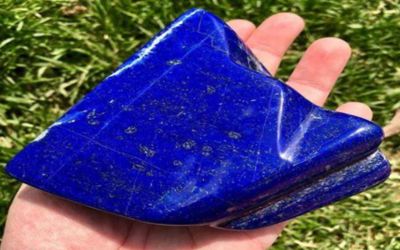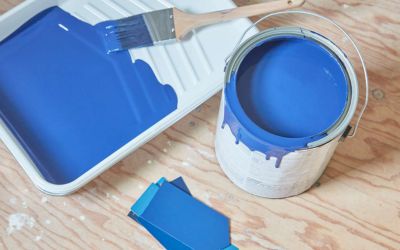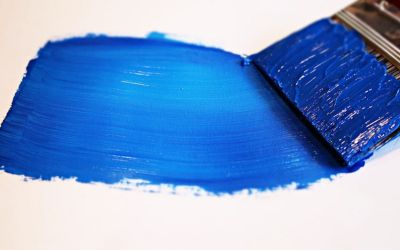In The Old Guitarist, Pablo Picasso used dark and vivid royal blue to depict melancholy and gloom.
Scholars have marvelled at the artist’s portrayal of depression in the painting.
You will also learn the exact colors and different shades of the paint and how to measure and mix them in the right proportion for your art.
We have researched and tested various painting techniques and products, and here are our findings.
How To Make Royal Blue Paint
Combine ultramarine blue with alizarin crimson or magenta and cyan blue to create royal blue. Another option is mixing cobalt blue or navy blue with a purple hue. These color combinations will help you achieve the desired shade of this deep and vivid blue.
What Colors Make Royal Blue
Making the paint is easy and fun, and you can do it with different combinations of colors and shades of blue.
Mix ultramarine blue and alizarin crimson or magenta and cyan blue to get the perfect royal blue hue.
You can learn how to make cyan with paint or other combinations of colors to make different shades and hues of blue.
It is a deep and vivid blue that can create a sense of calmness, elegance, or mystery in your paintings.
You can also make it by mixing cobalt blue or navy blue with a purple hue. You will learn these alternatives later, including how to make the paint without blue.
But before we get into the specifics, let’s explore the exciting history of mixing blue pigments.
The History of Royal Blue Paint

The royal blue color originated in England in the 19th century when a dress of the same color won a competition for dressing Queen Charlotte, King George III’s wife.
For centuries, the paint has symbolized royalty, divinity, and art.
However, we discovered a darker blue pigment first. The most ancient blue pigment, lapis lazuli, can be traced back to Afghanistan 6000 years before the 18th century.
Miners extracted the blue pigment from the semiprecious limestone rocks of the Badakhshan mountains.
The first process involved extracting the main lapis lazuli (lazurite) component, which gives the stone its blue color.
The semiprecious rock was ground into a fine powder, washed to remove impurities, and heated with wax or resin to form a dark blue paste.
The thick paste would be dried and ground again into fine powder when painting or dyeing.
The paint entered Western Europe through the Silk Road trade routes between the second century BCE and the 15th century CE.
Ancient artists, painters, and fashion designers created the color by mixing the deep blue lapis lazuli with ancient pigments like Tyrian purple and orchil lichen.
Purple is a complementary color for yellow, the opposite of blue in the color wheel. Therefore, it can transform deep blue into a more vivid and saturated paint.
How to Make Royal Blue Paint: Step-by-Step Guide
Follow these steps to make a perfect royal blue for your project;
1. Gather materials
The materials you need include;
- Any shades of blue (dark blue color, brownish blue, turquoise, ultramarine blue, teal or cyan )
- Any shades of purple paint (alizarin crimson, magenta, bright purple or violet)
- A clean wooden, plastic, or paper palette
- Mixing tools such as a palette knife or mixing stick
- Protective gear, including gloves, apron, and mask
2. Prepare your workspace
An organized workspace sets the foundation for a successful and enjoyable painting process.
Select a clean and adequately ventilated area dedicated to your painting endeavor. Clear any clutter to allow ample and comfortable mixing.
An organized workspace allows more access to the painting materials and reduces the risk of accidental spills, which could alter the outcome of your painting.
3. Measure the paints
The precise pigment measurement is crucial because a slight imbalance can result in an undesirable shade of blue.
Use a measuring spoon or a scale to put equal amounts of ultramarine blue and purple paint. You can use any shade of blue or purple in your repository.
For instance, you can mix equal parts of dark blue and bright purple, ultramarine blue and dark purple, or navy blue and violet.
Adjust the ratios by adding more or less of one paint depending on your desired shade.
However, we strongly recommend mixing alizarin crimson and ultramarine blue. Mixing dioxazine purple with a darker blue shade is also recommended.
4. Pour the paints into the mixing container
Add equal amounts of ultramarine blue and alizarin crimson in a mixing container.
Use a mixing stick or palette knife to mix the paints in gentle swirling motions and minimize waste.
Observe the change and variations as the purple and blue colors intermingle.
However, since you used equal amounts of purple and dark blue, the resulting color might appear more purple than royal blue.
If that’s the case, intensify the blue hue by adding a small amount of color blue while maintaining the purple undertone.
Mix the paints to achieve a uniform, smooth, and consistent paint. Check the resulting color under different light conditions to ensure the lighting does not influence the perceived color.
Natural light is the most preferable light to use when mixing the paints.
5. Test the paint on a small area
This testing phase allows you to fine-tune the shade and make subtle adjustments.
The test piece should have a similar texture and color as your final painting surface, so you can see the interaction and make any adjustments beforehand. It’s like the anticipation before revealing a hidden gem.
Apply a thin layer of paint evenly and let it dry completely, and monitor the color change under various lighting conditions and viewing angles.
Evaluate its depth, vibrancy, and resonance with your artistic vision. For instance, does it resemble the shade in your reference image?
If not, adjust the hue by adding more ultramarine blue color, purple, white, or black.
If you are happy with the result, use the paint in your project.
6. Store the paint in an airtight container in a cool, dry place
Although making royal blue is easy and fun, it would be overwhelming to make it every time you need to use it on your painting projects.
Therefore, the final step is to store it in an airtight container in a cool and dry place.
Do not keep the paint in a sunny location or extreme temperatures to avoid fading and separation between the colors in the paint.
But most importantly, label the container with the name and date you made it, so you can use the paint before it expires.
Alternative Ways of Making Royal Blue

While dark blue hues and purple are the primary and secondary colors for making navy blue, other alternatives exist.
How to make royal blue from navy blue
Remember that you can derive royal blue from any blue hues, including navy and cobalt blue
As noted earlier, thoroughly mixing navy blue and purple is the fastest, most recommended way.
Like navy blue, purple is also a mix of color blue and red. So, it mixes with navy blue more vibrantly and less dully, which is royal blue.
However, the exact royal blue shade depends on how much navy blue and purple you use. You can also lighten navy blue using white paint or darken it with black paint.
Read this article to note the difference between royal and navy blue.
How to make royal blue from light blue colors
You can still make the paint from light blue. Add light blue to a mixing container with a small amount of magenta or purple.
Add more magenta or purple if you want a darker royal blue.
Combine red and blue paint (equal parts) if you don’t have purple. Add the resulting purple to the base color and use a palette knife to mix them thoroughly.
Experiment with the resulting royal blue hues until you get the desired one.
For example, use more light blue and less magenta or purple paint if you want a lighter shade.
Use more magenta and less base paint if you want a darker royal blue.
How to make royal blue without blue
Did you know you could also make royal blue from light blue hues? Although subtractive mixing is challenging, enhancing creativity would be fun.
It means mixing paints of different colors to delete the wavelengths of each other and reflect the desired hue.
In that case, you can mix equal parts of cyan and magenta to create a dark and vivid shade of blue with a slight purple color.
Lighten the color with white paint to get a royal blue hue. Test the color on scrap paper or canvas before applying it to your project.
How to Make Royal Blue Acrylic Paint
Royal blue acrylic paint is deep and rich with blue color, but you can also notice a slightly purplish undertone.
You can draw and create vibrant, bold, subtle, and elegant art pieces.
Gather your materials, including cyan, magenta, white acrylic paint, a mixing palette, and a mixing knife or spoon. Ensure your paints are high-quality.
First, mix equal parts of cyan and magenta paint to create a dark purple acrylic paint.
Add a small amount of white acrylic paint to the mixture to lighten it and create a royal blue hue.
You can adjust the shade using purple, black, white, or magenta.
Mix the paints thoroughly and test them on scrap paper or canvas before applying them to your project.
Some tips include experimenting with cyan, magenta, and white paint shades.
With a bit of practice, you’ll be able to make your own beautiful royal blue acrylic paint that you can use to create stunning works of art.
How to Make Royal Blue Watercolor
Royal blue watercolor is ideal for creating soft, delicate washes of color, which ensures the paper can be seen through the paint.
Prepare a primary ultramarine blue watercolor paint, magenta paint, white watercolor paint, a mixing palette, a mixing spoon, and a watercolor storage container.
Mix equal parts of the primary colors to create a dark purple color.
Alternatively, you could add black watercolor paint to blue watercolor paint to get a darker variation of royal blue.
Note that paint fumes can be harmful. Therefore, mix the watercolors in a well-ventilated area.
Apply the paint to your project with a wet brush or a tool of your choice.
You can also use techniques like wet-on-wet, wet-on-dry, or dry-brush to create different effects in your painting. Here’s more on dry brushing acrylic paint.
Royal Blue Color Wheel

This is a color wheel of royal blue only. It has eight different shades of royal blue including #1d44b8, #214cce, #2b58de, #4169e1, #577ae4, #6d8ce8, #839deb, and #a0b3f0.
The blue colors move from a very dark and intense royal blue of high saturation and low brightness to a very pale and delicate shade with low saturation and high brightness.
There are two ways to stay within the royal blue color wheel – by mixing it with white color or light blue to add a touch of brightness.
A color wheel designed specifically for royal blue is significant to artists and designers.
It can help you understand the complementary, analogous, and split-complementary colors that harmonize effectively with the color.
The complementary color for each shade can be determined by finding the color opposite it on the color wheel.
The complementary colors would be warm shades like orange, orange-red, burnt orange (#FF703D), or vermilion (#E34234).
Applications of Royal Blue
Royal blue has so many use cases.
Interior decoration with royal blue
One way to incorporate the paint into interior decorating is by painting one wall in a room with it and the others in a lighter blue color.
This technique creates a focal point, drawing attention to the royal blue wall and adding depth to the space.
The contrast between the warm blue shade and the light-colored walls creates a visually appealing balance, making the room feel larger and more open.
Use the paint on the ceiling to infuse a sense of grandeur into your living room or bedroom.
This unexpected choice adds a touch of drama and elegance to the space, elevating its overall aesthetic.
The rich royal blue above creates a sense of height and spaciousness, giving the room a luxurious ambiance.
You can also incorporate it on furniture pieces to add a bold pop of color. A royal blue sofa, chair, or accent table can serve as a statement piece, adding vibrancy and personality to a room.
Against a backdrop of neutral walls and furnishings, the furniture becomes the focal point, creating a captivating visual impact
Royal blue in fashion and style
It is a transformative color within fashion and style. A royal blue dress or suit for a formal event evokes an undeniable sense of sophistication and elegance.
Pairing it pants with a crisp white shirt or blouse exudes confidence and power, subtly commanding attention.
Introducing a royal blue scarf or accessory becomes an artistic stroke that adds a delightful pop of color, infusing personality and intrigue into any outfit.
Royal blue in art and photography
Royal blue takes on a transformative role as a background color, imbuing images with depth and drama.
It conjures a sense of mystery and vastness, as seen in the atmospheric night sky or the sprawling expanse of an ocean scene.
Whether used as an accent to enthral the viewer’s gaze, a background to evoke emotions, or a complementary partner to strike a harmonious balance, royal blue color emerges as a formidable ally in pursuing artistic expression.
Its presence breathes life into images, imprinting upon them an enduring impression within the discerning eyes of the perceptive observer.
Colors That Compliment Royal Blue
Royal blue pairs well with cool colors like orange, teal, and green. Blue and orange combined create a striking pairing further enhanced by cool colors like teal and green.
Green and blue match beautifully as green is the complementary color to red, the opposite of blue on the color wheel. It complements blue in color schemes and design.
Different shades of green like bright cool green or hunter green and forest green, provide a stunning contrast.
Blue mix yellow creates a vibrant shade of green. Golden yellow beautifully enhances royal blue, creating an eye-catching combination that captivates the senses.
Golden yellow’s warm shades combine royal blue’s deep, regal color to provide richness and sophistication.
However, pair it with shades of gray or silver for a more serene and calming effect.
The cool, neutral tones of gray or silver provide a subdued backdrop that allows royal blue to shine as the focal point.
This combination exudes a sense of refinement and modernity.
Royal blue and brown mixed make an elegant pairing in interior design. The warmth of brown harmonizes with the calming nature of blue, creating a balanced atmosphere.
Indigo complements royal blue as they are shades of blue, close on the spectrum. Blue and indigo create harmony when paired, offering depth and variation while maintaining unity and balance.
Royal blue and pink mixed color create a visually striking balance. The warm and vibrant nature of pink contrasts nicely with the deep and bold richness of royal blue.
Related post: How to make the color aqua?
FAQs
What two colors make royal blue?
The two primary colors making royal blue are true blue and dioxazine purple. Blue is the base color, while purple adds depth and richness to the mix.
How do you make dark royal blue?
Add a small amount of black paint to darken the hue while maintaining its inherent richness and intensity.
How do you brighten royal blue?
Mix shades of white to the paint. White paint introduces more reflected light and increases the overall brightness of the mixture.
What color offsets royal blue?
Mint green and pink interior design harmonizes with yellow and cadmium orange accents, evoking various moods. Teal complements royal blue, creating a vibrant and balanced space. The dynamic duo of blue and orange enlivens the room with energy and warmth.
Is royal blue bright or dark?
It is lighter than navy midnight blue but less light than sky blue. It is a vivid and deep shade of blue color with red or purple undertones.
Conclusion
Royal blue is fun and easy to make using ultramarine blue and alizarin crimson.
Follow the steps in this article to create your custom shade that is perfect for any project.
The shades of blue you use will affect your final color. Use ultramarine blue for a deeper and richer royal blue.











Leave a Reply